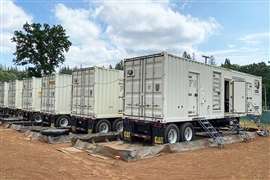How alternative fuels fare in the extreme cold
09 July 2024
Recently, Power Progress reported on research done by Canada’s Alberta Motor Transport Association (AMTA) regarding the use of hydrogen fuel in extreme cold temperatures.
It turns out that when the mercury drops, other alternative fuels face similar challenges.
Jeffrey D. Naber, the Richard & Elizabeth Henes Professor in Energy Systems at Michigan Technological University, used fossil diesel in compression-ignited engines as a point of reference.
“Diesel fuel has relatively low volatility,” Naber said. “That means it’s hard to vaporize and mix at low temperatures. It has some paraffins in it, so typically it will begin to wax at low temperatures.”
According to Matt Leuck, technical manager, Renewable Road Transportation, North America for sustainable fuel maker Neste, cold-weather operation for diesel fuel is a function of the kinds of molecules the fuel contains.
“If you have longer-chain, heavier diesel molecules, those are going to gel up quicker,” he said. “If you have shorter-chain, lighter diesel molecules, those are going to stay liquid longer.”
Additives allow the diesel fuel to flow at lower temperatures for cold-weather operation while not being too volatile for summertime use, Naber said, as well as other methods to promote ignition.
“We rely on the heat of compression plus potentially some other mechanisms to get the temperatures in the cylinder such that the fuel auto-ignites,” he said.
HVO and biodiesel
One alternative to fossil diesel in compression-ignited engines is renewable diesel, also known as hydrotreated vegetable oil (HVO). Leuck said that while cold temperatures cannot really be addressed once renewable diesel has been produced, much can be done in the refining process to address cold-weather operation.
 Neste MY Renewable Diesel at K.W. Rastall Oil’s North Brunswick, N.J., truck stop. Neste recently announced a partnership with the township of North Brunswick to enable all of the township’s diesel vehicles and equipment to switch to renewable diesel. (Photo: K.W. Rastall Oil)
Neste MY Renewable Diesel at K.W. Rastall Oil’s North Brunswick, N.J., truck stop. Neste recently announced a partnership with the township of North Brunswick to enable all of the township’s diesel vehicles and equipment to switch to renewable diesel. (Photo: K.W. Rastall Oil)
“We can basically say we want to make this grade of fuel,” Leuck said. “We can say we want to make a cloud point of X, Y or Z, and we can nail that any day of the week because of the technology we have in the production process.”
Leuck added that the cloud point is the point at which wax crystals begin to form.
Another fossil diesel alternative is biodiesel, which is also produced from similar feedstocks to renewable diesel but via a different refining process. According to Naber, however, it does not behave much differently than fossil diesel in the bitter cold.
“Biodiesel tends to have long [hydrocarbon] chains and tends to wax just like diesel fuel, so it has a problem at low temperatures,” Naber said.
Leuck said that unlike renewable diesel, the biodiesel refining process coupled with the types of feedstocks limit what producers can do to adapt it to bitterly cold temperatures.
“They can only break apart the feedstock, but they can’t put more hydrogen back into that fuel molecule,” Leuck said, referring to the hydrotreating process in renewable diesel that creates paraffinic hydrocarbons. He added that the biodiesel process does not allow for isomerization of the molecules, which is the step in the renewable diesel refining process that really defines its cold-weather properties.
Naber said that paraffinic compounds — those that are long chain, straight chain or isoparaffinic — have a high cetane number.
“Cetane number is its characteristic ability to auto-ignite,” he said. “So that’s good. The more cetanes I have, the more paraffinics I have, the lower temperature [at which] it will auto-ignite.”
He added, “Depending upon how the renewable diesel is produced, typically — again, it depends on the process — it tends to have more of these long-chain hydrocarbons that have a higher cetane number. They also have less sooting capability. But these fuels typically have higher waxing points.”
Spark-ignited options
Alternative fuels are also available for spark-ignited engines. One that is often used is ethanol, which Naber said “has a low volatility, so it’s also not good for cold-temperature starts.”
He added, “We could go to gaseous fuels. The advantage of a gaseous fuel is I don’t have to vaporize it.”
Both liquified natural gas (LNG) and liquified petroleum gas (propane, or LPG) will still vaporize under normal conditions, even at low temperatures, Naber said.
 A liquefied natural gas (LNG) storage tank. (Photo: Adobe Stock)
A liquefied natural gas (LNG) storage tank. (Photo: Adobe Stock)
“One of the challenges with natural gas is, like air, when it expands, it cools,” Naber said. “I have to expand it from the high-pressure tank, so cooling can be pretty significant.”
He added that heat exchangers can ensure the fuel going into the cylinder isn’t too cool.
In internal combustion engines, Naber said that hydrogen operates similarly.
“I need to have liquified hydrogen stored cryogenically, or I could have it in a compressed tank,” he said. “It doesn’t quite cool as much when you expand it. It has different thermodynamic properties.”
However, like natural gas and LPG, it doesn’t need to be vaporized.
“I just need to mix it — get the right quantity with air — and ignite it with a spark,” Naber said.
The challenge with spark-ignited engines at cold temperatures is getting the right stoichiometric mixture of fuel and air at the time of spark ignition, Naber said.
Despite these challenges, engines are better than many other technologies at operating in extreme cold conditions.
“If you think about an engine, it actually can operate at an extreme set of temperatures compared to just about any other device that you can think of,” Naber said. “Batteries have challenges at low temperature. Fuel cells have problems at low and high temperatures. So, an engine is quite robust to temperature overall.”
STAY CONNECTED



Receive the information you need when you need it through our world-leading magazines, newsletters and daily briefings.
CONNECT WITH THE TEAM











